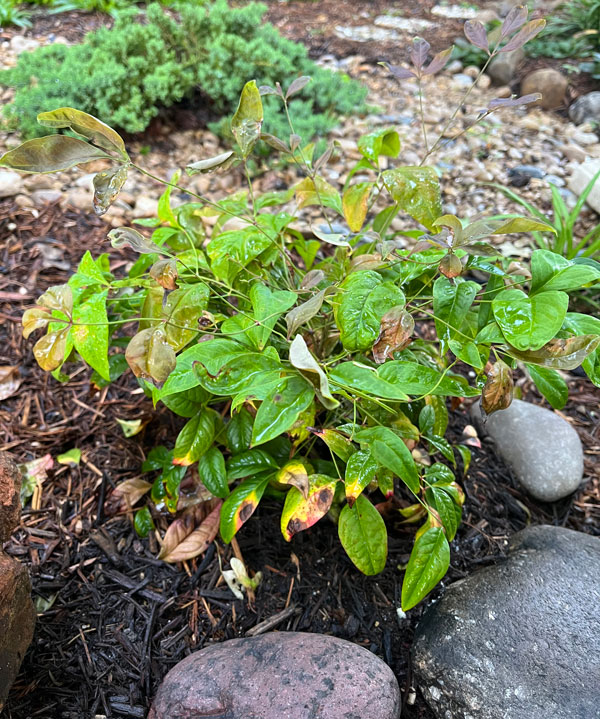Q&A – Ask Neil: May 1, 2025
(Please read these instructions carefully.)
Before you post your question, please look at recent issues to see if someone else has already asked it. You might find your answer there.
How to submit your question…
(Note: You may need to allow a pop-up window to come up in order to get the link for sending your photo(s). If you have already submitted your question and didn’t see the pop-up window, please click here.)
• Click the link provided below to post your question. After you submit your question, a new window will pop up giving you the address to which you can e-mail a SHARP, HIGH-RESOLUTION PHOTO to accompany your question. Please DO NOT SEND THUMBNAIL PHOTOS in case I need to zoom in to see things.
• Click here to post your question.
• Please ONLY POST YOUR QUESTION ONE TIME. We can only accept a set number of questions each week, and when we get duplicates it costs other people their chances.
• One question per reader, please.
• Please use this only for posting questions – not for standard emails.
• Watch for your answer in the following week’s e-gardens.
• I choose those of greatest general interest. For example, plant IDs seldom make the cut.
• I must have your first name or initials.
• I must have your city or county. (Texas is a very large state.)
QUESTION 1
WHY ARE MY YELLOW AND WHITE ROSES TIPPED IN BROWN?
Question: My roses came on strong in growth, but the yellow and white roses are brown tipped. Toni L., Plano.
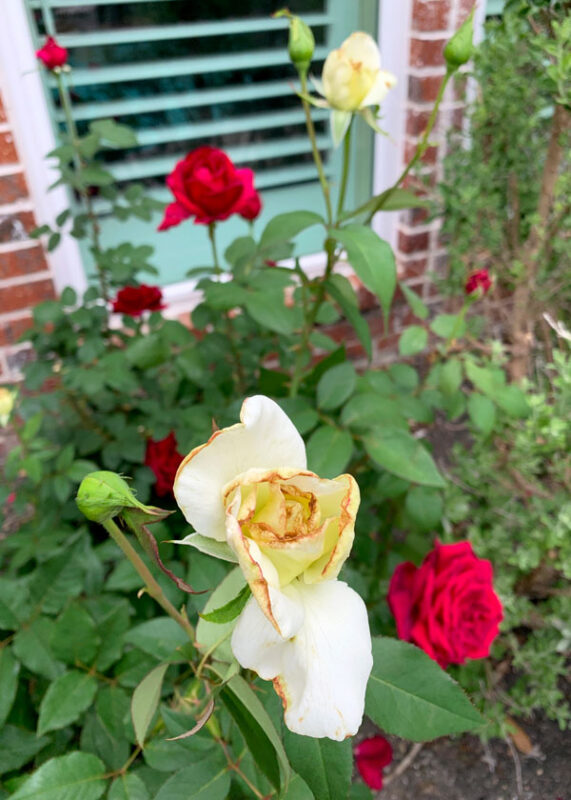
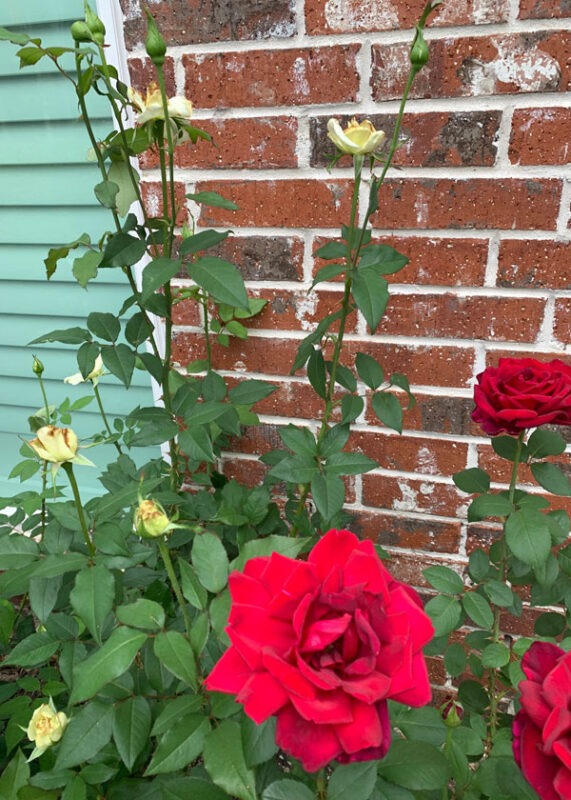
Answer: Thank you for this question. I am so exhausted after 15 years of answering almost exclusively rose rosette virus questions that to get a question and photos of what looks like damage of thrips is like a refreshing trip back in time.
Thrips are tiny, whisker-shaped insects that populate the insides of tightly petalled flowers such as roses, gardenias, mums, and others. They have piercing/sucking mouthparts and where they feed, they cause the petals to become discolored. If there are a few, you will see spots of a contrasting color. Where are many, the petals will turn brown and crisp, and the buds will fail to open properly. Peel one of the affected flowers open over a sheet of white paper and thump a bud over the paper. Look closely to see if any tiny slivers start to move about, either on the paper or within the bud. If you see them, apply a systemic insecticide labeled for roses. However, it’s probably too late for this round of blooms. But at least you’ll know how to protect your fall crop.
In the meantime, read up on RRV and watch for it. It’s a serious problem especially in the DFW area where you are. I leave information on it archived on my website.
Giant uh oh…: As I was editing your photos above (last step in finishing up the Q&A section of e-gardens) I saw a blurry image on the right edge of the white-rose photo. It runs vertically along the right side of that photo. Is that a rose bush or climbing rose? If so, its stem looks like it might have the telltale symptoms of multitudes of thorns. That’s a giveaway for rose rosette virus. I don’t want to scare you because I really can’t see it very clearly at all, but you do need to look closely and compare it to the photos and information in the link I posted above.
QUESTION 2
WHAT CAN I DO TO HELP MY MAGNOLIA TREE? WILL IT GROW BACK?
Question: A portion of the bark on my magnolia tree is missing. The tree appears to have slowed growing. What can I do, and will it grow back? Slade M., Travis County.
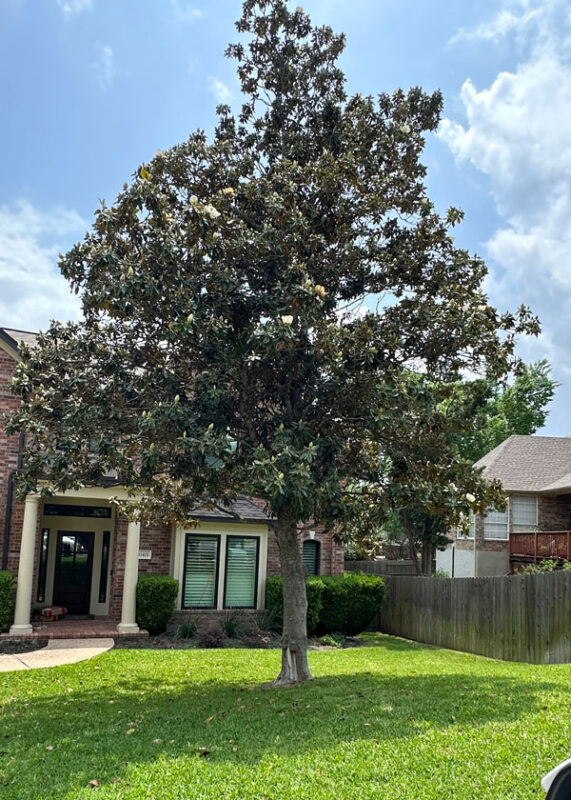
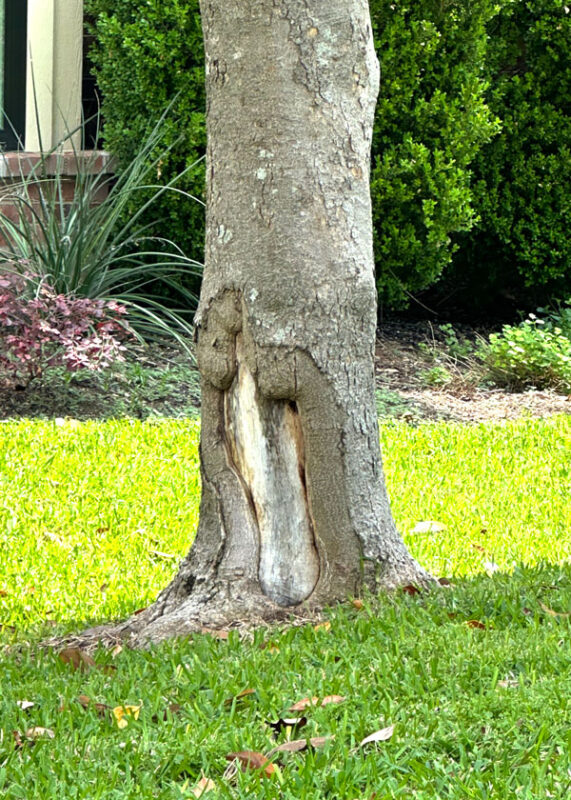
Answer: Something gouged this tree badly 4 or 5 years ago. It could have been a mower wheel, or I guess it might have been a line trimmer, although it seems like that damage would have been more parallel to the ground.
Tissues that carry nutrients and water to the leaves line up on the same side of the trunk from the ground to the leaves – if the slowed growth is any more pronounced on the side of the tree where the trunk has been hurt, that’s the reason. Hopefully it will outgrow it.
The tree has already started to form a strong roll of new bark. It will grow until it meets itself across the wound, probably in the next two years. It would never hurt to hire a certified arborist to look after your tree. That dark streak coming down the internal wood is the only thing that concerns me at all. The arborist would know what to do after he or she could look at it closely.
QUESTION 3
WHAT HAS HAPPENED TO MY POMEGRANATE?
Question: My pomegranate is in rapid decline over the past two weeks. Is this fungal or bacterial? Is there any chance of saving it? There is some new growth at its base. Miranda B., Pflugerville.
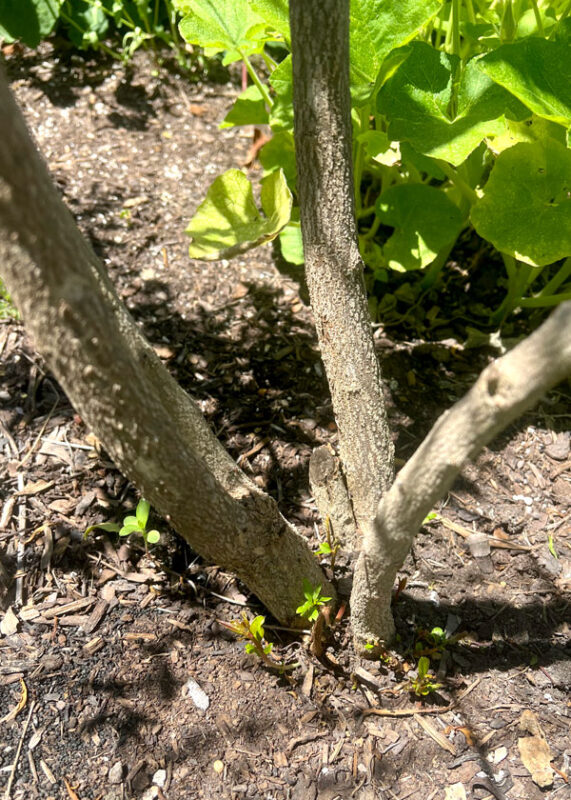
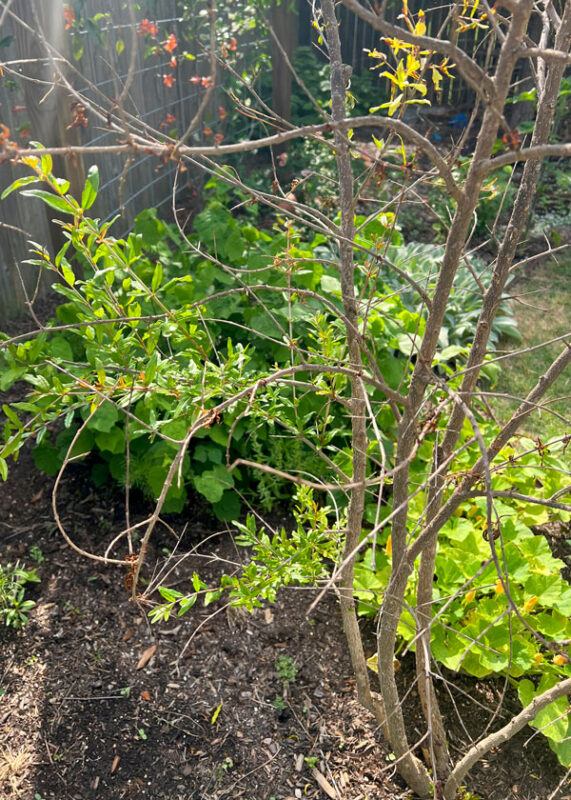

Answer: I’m going to have to answer your questions in bits and pieces because I don’t recognize a clear path to victory.
Pomegranates are occasionally hurt by our winter cold spells. Such was certainly the case in February 2021. It has also been the case with some record cold weather other times in the past 20 years. If your plant was particularly exposed, this could be latent cold damage, and that would account for why it is sending out sprouts from its base.
I’m not aware of any disease problems, either fungal or bacterial, that impact a pomegranate in that way. Cotton root rot could, but it would not allow sprouts to be developing. The entire plant would be dying from the roots up. Cotton root rot “leaves no survivors.”
This looks like broadleafed weedkiller damage, but nothing nearby was hurt, so that’s almost assuredly not it. Plus, the sprouts would have been hurt.
So, 3 strikes (I think) and I’m out. I spent 30 minutes researching pomegranates and any other problems that befall them online and what you’ve just read is the best I can do. I would just trim off the dying stems and see how the sprouts develop. You might also want to plant a new pomegranate somewhere else in your yard, just to get a fresh start.
That’s all I have. I’m sorry.
QUESTION 4
HOW CAN I KEEP WEEDS OUT OF MY PERENNIAL BEDS?
Question: Weeds are very bad in my perennial beds this year. How can I stop them? Would mulch prevent summer phlox and periwinkles from reseeding? Mary G., Longview.
Answer: If those are your weeds, I’m getting off easy. Yes, mulch would be perfect. I would put a couple of inches of well-rotted compost or shredded tree leaves over the ground. If might be better if you have a small hoe and can sharpen it, then scrape the soil first when it is moderately dry. Those seedlings won’t come back when they’re cut.
In the off chance that you also have some grassy weed such as bermudagrass, I would spot treat those carefully with a glyphosate-only herbicide (no other active ingredients). That would kill the weeds without contaminating the soil. You could use a large piece of cardboard to mask off the perennials with one hand while you spray with the other. Or, you could use a foam rubber paintbrush to swab across the bermudagrass with the herbicide while wearing disposable rubber gloves.
QUESTION 5
WHAT ARE THOSE PINK SPOTS ON MY PINK BLUSH NANDINAS?
Question: What are the pink spots on my Pink Blush nandinas? How do I treat them? Janice Y., Mesquite.
Answer: If you’re talking about the reddish spots on the lower leaves in your photo, those are last year’s leaves getting ready to be shed. No cause for concern at all there.
I also am seeing some scorch on the newest leaves where it looks like direct afternoon sun might have beamed onto the new growth, perhaps when it was wet like it is in your photo. It could have done damage to the tender tissues. Those spots are going to get dry and brittle as well. I’d love to be able to converse back and forth to ask if you might have applied fertilizer a few days before any of this top browning happened. It looks like something else could have been involved, either that or a drift of weedkiller – something that has affected the foliage.
I don’t know if you remember the old Nana nandinas. They were also dwarf types with similar large, crinkled leaves. They grew well for a few years and then started to go downhill when they were grown in alkaline soils like you have in Mesquite. While I’m a big fan of the other, smaller-leafed nandinas like Harbour Dwarf, Harbor Belle, and Flirt, among others, the Nana types have never called my name. I would suggest you just sit tight for a few weeks to see how this plant snaps out of this.
QUESTION 6
WHICH TYPE OF ST. AUGUSTINE WOULD BE BEST FOR MINIMAL SHADE?
Question: I am replanting St. Augustine. Which type would be best for minimal shade (6 hours of sun) and most resistant to take all root rot, other funguses, and chinch bugs? Raleigh, Palmetto, or America? What are your thoughts on Tif Turf bermuda? Randa M., Travis County.
Answer: In other words, which the perfect grass? Sadly, I’m not sure it exists yet. I’ve had Raleigh for 40 years and have been happy with it. Not “jumping up and down” happy but pleased. Palmetto gets very good marks and probably would be my choice if I were planting St. Augustine now. I’m sorry, but I am not familiar with a variety called ‘America.’ Extensive Web searching just now yielded nothing.
By the way, I would not call 6 hours of shade “minimal.” That’s actually just about the reverse of what I normally tell people. If you have less than 6 hours of sun, you’re probably going to watch your St. Augustine fade away. So many people think that St. Augustine requires shade. I remind them that sod farms are always in full sun. Perhaps I misunderstood your wording.
As a side note on this topic, I’ve been asked about zoysias. I am certainly aware that there has been a great deal of progress in them. I encourage you to check into them for your specific situation. Ask a couple of reputable sod vendors in your area for their thoughts, and ask to see two or three zoysia yards that were planted at least two years ago. Both times that I have planted zoysia it has been invaded and overtaken by bermuda.
QUESTION 7
WHAT CAN I DO TO GET MY ST. AUGUSTINE TO THICKEN?
Question: My St. Augustine isn’t as thick and dense as I’d like. How do you remove thatch without pulling out a lot of the good grass? What can I do to encourage density? I water twice weekly but deeply, and I fertilize according to your recommendations. What else can I do? Janet M., Coppell.
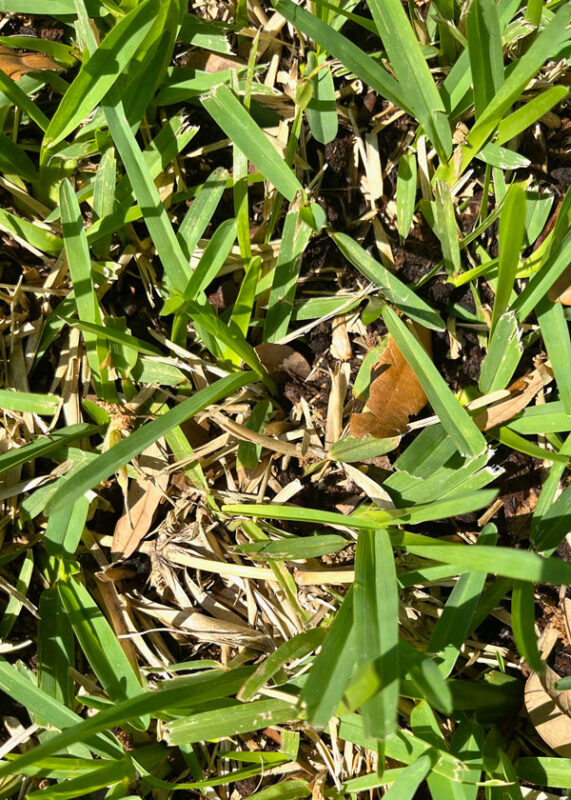
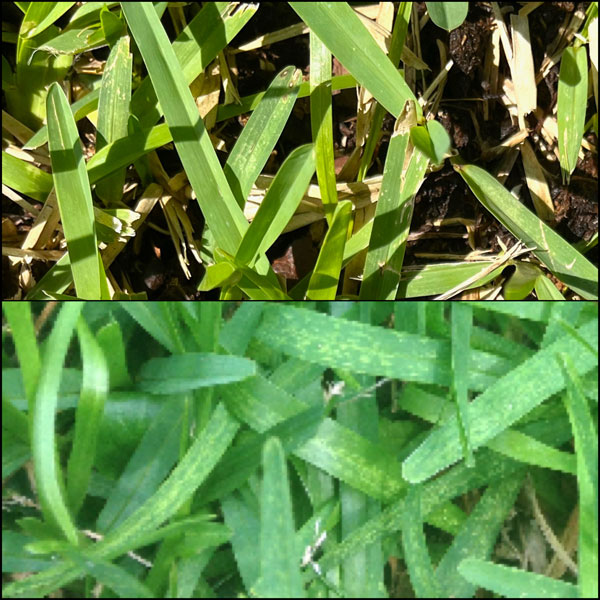
Janet’s photo on left. Upper right: Zoomed view of upper left corner of Janet’s photo. Bottom right: Confirmed St. Augustine decline from LSU Ag Center website for comparison. Please ignore variations in brightness of green of blades. Look mainly at the mottling.
Answer: Let’s go through the things you told me. First, St. Augustine rarely has thatch. What I see in your photo is just browned stubble. Thatch is undecomposed organic matter, often unrecognizable as leaves or runners, that is found between the surface of the soil and the runners. (Beneath the runners.) You don’t want to try to dethatch your St. Augustine because you would be tearing away the healthy runners.
Twice-weekly waterings might be fine at 100F, but that’s way too much with the conditions we’ve been having, especially if you are watering, as you said, “deeply.” You need to have a “smart” controller installed that will monitor the needs of your woody plants and turf against the weather conditions to determine when it’s time to water. Or, if you’re using a hose and sprinkler, check the soil each time before you turn things on.
Third, and this one is a giant reach: I think you ought to have your grass looked at by the Texas A&M Plant Disease lab in College Station. I see a few mottled areas on the blades in your photo that caused me to worry about St. Augustine decline. It’s a virus disease that struck Texas in the 1960s and 70s. It’s still around if you happen to have “Common” St. Augustine. That’s probably not what you have, but at least you should watch to see if the mottling becomes any more evident. I’m going to include a photo from the LSU Ag Center that shows you what SAD looks like as it advances. They also have some very good written information on their websites. In the very unlikely chance that SAD is involved, you will need to replace your lawn with a resistant variety. We’ll cross that bridge later if we have to. It would start with confirmation. Any sample you send to the lab should have runners with mottled blades. If you do not find them, then I’m on the wrong track.

